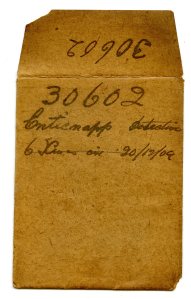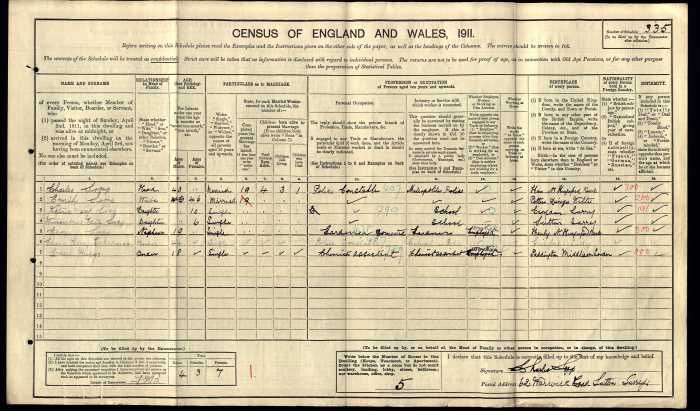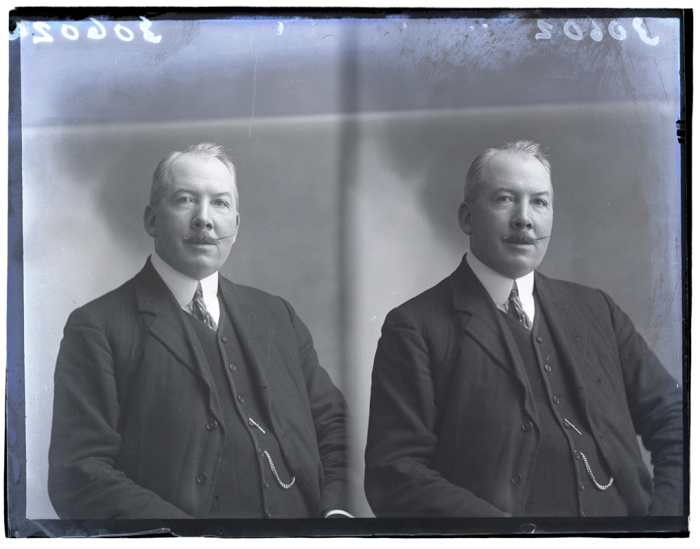One of the many advantages of working in a team is the collaborative experience that can be brought to bear on all aspects of the work we carry out. This can be useful for tasks as simple as interpreting handwriting on an envelope or offering technical advice. Or, as in this case, in which an individual recognised an unusual name on an envelope and a tenuous possible family connection, for picking up details that may otherwise have been missed. The research of today’s individual came about purely from a casual debate in the office about what the name of this particular sitter might be. This blog has previously touched on the difficulty of interpreting handwriting on envelopes. During the process of cleaning and rehousing our glass plates it is common for volunteers to debate possibilities for a few minutes, mulling over a particular letter or title, trying to get it right.
 In this instance a number of us had puzzled over the slightly blurred name written on the envelope for a moment or two before a member of staff took a look and immediately identified the name as ‘Enticnapp’, a version of a name she had come across during research into a branch of her extended family. The spelling was slightly different to that encountered in her own research but we know from experience that names were not always accurately recorded by the studio staff. With such an unusual name and the added bonus of ‘Detective’ on the envelope the possibility of locating information about this character seemed a good bet and so the research of this particular individual became a joint effort between the volunteer who cleaned the plate, Rita Argent and the member of staff who was interested in discovering if a family connection existed.
In this instance a number of us had puzzled over the slightly blurred name written on the envelope for a moment or two before a member of staff took a look and immediately identified the name as ‘Enticnapp’, a version of a name she had come across during research into a branch of her extended family. The spelling was slightly different to that encountered in her own research but we know from experience that names were not always accurately recorded by the studio staff. With such an unusual name and the added bonus of ‘Detective’ on the envelope the possibility of locating information about this character seemed a good bet and so the research of this particular individual became a joint effort between the volunteer who cleaned the plate, Rita Argent and the member of staff who was interested in discovering if a family connection existed.
In today’s blog Rita explains just how they went about researching Detective Enticnapp, and what they discovered about him.
“As we so often do, we started our search into Detective Enticnapp by looking for the name in the 1911 census. Disappointingly there were no results in the Sutton, Belmont, Carshalton, Cheam, Epsom and Ewell areas but I wasn’t too surprised as it is an unusual name and easily mis-spelt. Because of the title ‘Detective’ we assumed a police connection and it was suggested that we look at the Proceedings of the Old Bailey; 1674-1913, and here we found him cited in witness statements for two cases in the F Division-Covent Garden area as Charles Enticknap (spelt with a K and one P).
The first case was for theft and burglary on 25 July 1898 in which Thomas Evans (23), Thomas Briggs (22), Henry Wallace (23), Henry Wheeler (28), and Emily Macmillan (19), were indicted for a burglary in the dwelling-house of Clement Valentine Parsons, and stealing tools, value £8. In his witness statement, Charles Enticknapp is quoted:
“I was with (Detective) Barnett…we saw Macmillan in the Edgware Road, and followed her into Hyde Park, where she joined the other prisoners… we got assistance and surrounded them… I seized Wallis, and a uniform constable collared the female, and another constable collared Wheeler, and they were taken to the station… I searched Wheeler… he was wearing this handkerchief round his neck, and this other he had in his hand… he said, “I bought that at the Salvation Army”… they were all charged with burglary… they made no answer to the charge.”
The defendants were found guilty with two of them receiving penal servitude, one getting nine months’ hard labour and two received up to six months in jail.
On the 13 May 1901 Charles Enticknap (Detective F) also gave evidence against a Thomas Jones for feloniously wounding Joseph Trump, with intent to do him grievous bodily harm. Jones was found guilty of unlawful wounding and given nine months’ hard labour.
Further reference to his active service is found in London and regional newspaper articles from the time (Images courtesy of Find My Past):
More information on Charles Enticknap’s time in the Metropolitan Police force was found on the The National Archives website. Charles H Enticknap joined the London Metropolitan Police on 4 July 1887; warrant number 72749. His last post was to W Division, Clapham as a PC. He then resigned on 14 July 1913. Although his rank is always listed as PC, he is referred to in Court Proceedings and in numerous newspaper articles as ‘Detective’ and we can only assume that he was assigned to the CID at equivalent rank to a uniformed PC.
Armed with the first name Charles we accessed the Surrey Electoral Registers on Ancestry and found him in the 1911 edition listed as a lodger at 62, Warwick Road, Sutton and paying the princely sum of 5/6d per week for two furnished rooms to his landlord Mr C. Sopp of the same address. This was the local connection for which we had been looking.
Mr Sopp’s name gave us another lead to follow. We returned to the 1911 census and found Enticknap mis-transcribed as C. H. Enchereds; a Police Constable (PC) with the Metropolitan Police.

1911 Census listing C.Enticknap, wrongly transcribed as ‘Enchereds’. Source: Find My Past. Reproduced courtesy of The National Archives, licensed under Open Government Licence v2.0
He is a bachelor, aged 44, lodging with Charles Sopp, also a PC, and his family. This was too big a coincidence to be anyone else. We were unable to trace Charles on the 1901 census.
Charles Henry’s birth was registered Oct-Dec 1865 in the district of Guildford, Surrey. We eventually find him on the 1871 census with his parents James and Keren Happuck Enticknap. On the 1881 census, aged 15, he is a brick apprentice living with his parents and seven siblings. By 1891, aged 25, he is a police officer resident at Police Station H Road, Paddington with other PC’s.
Charles died at the age of 76 between October and December 1940 in Surrey.
The name Enticknap is said have originated from a lost village in Surrey which was formerly recorded as “Anecknappe”. In translation this is thought to mean “valley of the wild duck”; “knappe” meaning a valley. Either as a result of the Enclosure Acts or as a result of plague around the 15th century the inhabitants of the village migrated, some going into neighbouring Sussex, taking on the name of the village as their surname. While we believe the surname Enticknap is now very unusual in Surrey it is not an uncommon name generally.
The establishment of a common ancestor with our staff member’s family proved a little more difficult to pin down but we think we’ve finally cracked it. Gilbert Enticknap, the grandfather of a living known descendant does indeed appear to be connected to our detective after all. It took some detective work of our own but it seems that Charles Henry’s great, great grandfather was also the great, great, great grandfather of our man.
Since the start of the project we have actually been lucky enough to establish and have communication with a very few living relatives of some of the subjects we have researched but this is the first connection to one of our team. Although the link is very tenuous indeed, it reinforces the very local nature of our project, focusing on REAL lives and real memories. For those of us invested in the project, this makes the work not only fascinating and revealing, but personal and important. The people pictured in these plates, who lived through times unimaginable to us, are gradually being revealed and their stories retold. Through this work they will be remembered in perpetuity by their addition to the local archives. It is something that many of us living in the digital (information) age may well take for granted.





Interesting. I too have an ancestor who was a pc in Metropolitan Police 1885 to 1888. He was George Enticknap and lived in Guildford after his service finished. Not directly related to this Charles Edward but I did come across the Kerenhappuch name during my researches. I have photos of George’s wife and children but unfortunately none of him.
LikeLike
Dear Tony, How very interesting – its does seem unlikely that the two men were unrelated. What a coincidence. Do let us know if a connection emerges. I am glad that you found our blog and am grateful for your interest and contact.
LikeLike
Well is a new met police Officer now. Laurence Enticknap
LikeLike
Pingback: Census 2021: Recording Life in Sutton | The Past on Glass & Other Stories...
The name Enticknap occurs in the district around Kirdford on the Sussex/Surrey border, near to where I live, as does Sopp.
LikeLike
Thanks for your comment Andrew – it certainly appears to be a far more recognised name than we first realised on discovering the envelope.
LikeLike